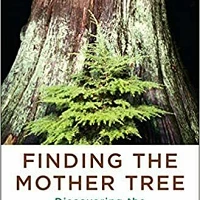But as awe-inspiring as that figure seems, the world's insect population is actually falling, Sverdrup-Thygeson notes.
"Our land use is changing a lot," she says. "We have removed a lot of flower meadows, dead trees in forests which ... [are] very important places for insects to live."
In her new book, Buzz, Sting, Bite: Why We Need Insects, Sverdrup-Thygeson writes about the dangers people face as the numbers of insects drop. The creatures play a vital role in pollinating crops, eating discarded food left behind on city streets, and feeding other animals in the food chain.
Sverdrup-Thygeson imagines all the species of the planet as a hammock in which insects act as a substantial part of the thread: "We can still rest in this hammock with a few loose threads and a few holes," she says. "But if too many threads will loosen, the whole fabric will unravel, and that will have a really serious effect for us humans as well."
Interview highlights
On how climate change can cause "ecological mismatch"
One of the things that is really scary with climate change is this risk of ecological mismatch, which means, for instance, if you think of insects pollinating flowers, you will need the flowers to be flowering at the same point of time as the insects are swarming — as the insects are out flying.
If one of these processes is governed by temperature — like, say, the insects will swarm when there is a certain temperature — maybe the flowering of the plants are more governed by daylight. And then you can imagine that with climate change now we are changing temperatures, but we are not changing daylight hours. And this means that these processes can move apart. And what happens then if the flowers are flowering at a stage where the insects are not flying yet, or the birds have chicks needing insects for food at this point of time when the insects are not flying? These things, I think, are really scary.
On the ripple effect of the insect population declining
Insect-eating birds depend on insects in order to survive. We know that if you take the amount or the weight of the insects that the birds on this planet eat in a year, that weight is actually equal to the weight of all humans on this planet. And then you understand that if insects are declining, birds will decline; freshwater fish will decline; bats will decline; some mammals will decline. And it's this sort of ripple effect that is one of the things that we might see happening if this insect decline is continuing and if it's like a global trend.
On insects as the new sushi
They are really high in protein — like certain types of insects can contain almost 70 percent protein, which is extremely high. Your normal beef would be [about] 20 percent. ... And this means that in a food security perspective, they can be really important. The United Nations has spent quite a lot of time researching insects as food, especially for children and also for pregnant women that can't move that far from their homes. They can be really important as a source of protein in certain communities and countries of the world, and even in the West. ...
You wouldn't eat a sheep with the wool on, so, of course, also with insects — they become much nicer to eat if you actually turn them into some foodstuff that doesn't look like a complete insect with legs and wings sticking out. ... You can make protein bars, for instance. That's definitely a way to go, or biscuits or something. ...
It's a bit comparable to eating sushi in a way I think. Because when sushi came along, most of us thought it was a bit strange to eat raw fish. It's not something that we were that used to in the West. But then it just took a few years and then it has switched completely, and now everybody is eating sushi. No one thinks that strange anymore. So maybe insects can be the new sushi in a few years.
On insects as the janitors of our cities
There's this study ... [of] ants in Manhattan, and they estimated that for each person living in Manhattan there would be about 2,000 ants for each person — and that's actually something that you should be happy about, because they eat a lot of junk food remains that people drop on the pavement or leave on the lawn in the parks. And they sort of calculated that these scraps of junk food that [are] put away by the ants of Manhattan, they add up to the equivalent of 60,000 hotdogs every year. And just imagine if that would sort of sit around not being removed. That would not be very nice. So I think we should be glad that they're there to clean away stuff that we don't want to have on our pavements or in the parks.
On how cockroaches could be used in the future to rescue people from a collapsed building
They are incredibly good at moving around. They can move at high speeds and they can get through different sort of hindrances, crawl over things, climb through things. Researchers have been trying to make use of that so that cockroaches can actually come to your rescue if you're trapped inside a collapsed building, or a building with a lot of pollution of some kind — like radioactive pollution. What they do then is to mount a little backpack on the cockroaches and they attach it to the antennas and to the back of the cockroach. And by using tiny electrical triggers they can remotely control several cockroaches and send them into a building. And in that way they can map the remains of the building and they can also have a microphone there in this little backpack, so that if people are trapped in there and they are crying for help, this can be recorded. And the people that are trying to rescue [them], they can come to the rescue right to the spot where people are trapped.
Lauren Krenzel and Mooj Zadie produced and edited this interview for broadcast. Bridget Bentz, Molly Seavy-Nesper and Deborah Franklin adapted it for the Web.
TERRY GROSS, HOST:
This is FRESH AIR. I'm Terry Gross. Summer is insect season. And for many of us, it's a reminder of what pests they can be. But my guest is here to remind us of how essential insects are to our survival. "Buzz, Sting, Bite: Why We Need Insects" is the name of a new book by Anne Sverdrup-Thygeson, a professor of conservation biology at the Norwegian University of Life Sciences. She's also a scientific adviser at the Norwegian Institute for Nature Research.
She studies the role of insects in trees and forests. But in her book, she writes about all kinds of things pertaining to insects, from their varied shapes, sizes and sex lives to their unusual powers that designers are trying to mimic in various forms of architecture and technology. For example, dragonflies provided the inspiration for drones.
Anne Sverdrup-Thygeson, welcome to FRESH AIR. I want to start by talking about one of the most detested of all insects, and that is the cockroach. I have never heard a defense of the cockroach that made me grateful for its existence. But you write about a potential life-saving way of harnessing one of the cockroach's greatest gifts, so I thought let's start there. What might cockroaches do to help us in the future?
ANNE SVERDRUP-THYGESON: The thing with cockroaches is that they are incredibly good at moving around. They can move at high speed, and they can get through different sort of hindrances - crawl over things, come through things. And researchers have been trying to make use of that so that cockroaches can actually come to your rescue if you're trapped inside a collapsed building or a building with a lot of pollution of some kind, like radioactive pollution.
And what they do then is to mod a little backpack on the cockroaches, and they attach it to the antennas and to the back of the cockroach. By using tiny electrical triggers, they can remotely control several cockroaches and send them into a building. And in that way, they can map the remains of the building. And they can also have a microphone there in this little backpack so that if people are trapped in there and they are, you know, crying for help, this can be recorded. And the people that are trying to rescue, they can come to the rescue, right to the spot where people are trapped. That's the idea.
GROSS: That's pretty remarkable. Has it been done?
SVERDRUP-THYGESON: No, it's on the research - it's being researched in the U.S., actually. And what might happen then is that, you know, the robotic technology might catch up with the true and real cockroaches before this is really put to use because they are also being used as models for small robots that can, you know, use the same technique of running quickly and coming through collapsed spaces. So maybe they will be, like, a big group of robotic cockroaches that you'll see instead.
GROSS: Great. So just as scientists have found a good use for cockroaches, they're going to be replaced by robots and just become pests again (laughter).
SVERDRUP-THYGESON: (Laughter) Well, they still have inspired the robots, though. So we can give them a bit of credit for that, can't we?
GROSS: All right, all right. You make a convincing argument that insects are a healthy and sustainable food that might make a good alternative to beef. In fact, you call insects mini livestock. What are their selling points...
SVERDRUP-THYGESON: Yeah.
GROSS: ...As a nutritious sustainable food?
SVERDRUP-THYGESON: They are really high in protein. Like, certain type of insects can contain almost 70% protein, which is extremely high. Your normal beef would be in the 20%-something. And this means that in a food security perspective, they can be really important. So the United Nations have spent quite a lot of time researching insects as food, especially for children and also for pregnant women that can't move that far from their home. They can be really important as a source of protein in certain communities and in countries of the world.
Even in the West, of course, we could eat insects if we wanted to as sort of an alternative to meat. And they also produce very little dung or methane or other sort of remains that we don't want to deal with.
GROSS: Unlike real livestock who produce a lot of dung.
SVERDRUP-THYGESON: Yeah, exactly.
GROSS: So when you talk about eating insects, you're not talking just about, like, you know, fried grasshopper or something. You see it more as insects being, for instance, ground into flour.
SVERDRUP-THYGESON: Yes, definitely. I mean, you wouldn't need a sheep with the wool on. So, of course, also with insects, they become much nicer to eat if you actually turn them into some foodstuff that doesn't look like a complete insect with legs and wings sticking out. And I think that's the way to go. You can make protein bars, for instance, or biscuits or something. And I think that is interesting, too, to farm insects as an alternative to meat, as a source of protein.
GROSS: I guess especially in the era of climate change, when we're really conscious about methane gasses being released into the atmosphere, since insects don't release that much methane.
SVERDRUP-THYGESON: No, exactly. And also the fact that the livestock that we eat, they take up a lot of the freshwater resources of the world. I mean, their grazing areas are enormous. They could partly be used for producing plant food for humans instead. Drawing down on our meat consumption is one thing that would help the climate issue. So - and maybe insects is one sort of step towards more vegetarian diet.
GROSS: When you talk about eating insects, there's also the yuck factor, that people think it's, you know, really disgusting to think about eating insects. Have you actually eaten food that has ingredients from insects?
SVERDRUP-THYGESON: Yeah, several times. But usually, you don't even taste it. If it's mixed into, you know, like, cookies or a cake or bread or whatever it is, you won't even notice it's there. But of course, if you taste them - I mean, some chefs would use ants, for instance, with this sort of, like, citric taste. That really adds a flavor to the food, and I've eaten that, too. And I think that's completely fine.
It's at least - it's a bit comparable to eating sushi in a way, I think, because when sushi came along, most of us thought it was a bit strange to eat raw fish. It's not something that we were that used to in the West. But then it just took a few years, and then it has switched completely. And, I mean, now everybody's eating sushi. No one thinks that's strange anymore. So maybe insects can be the new sushi in a few years.
GROSS: There is a vast number of insects on our planet. You write that there's quadrillions. So I had to look up what is a quadrillion. I thought a quadrillion was similar to a gajillion. There was basically, like, a made up word to mean, like, more than you can imagine.
SVERDRUP-THYGESON: (Laughter).
GROSS: But it's actually - it's one with 15 zeros afterwards, which is a lot of zeros. There's more than one quadrillion insects on the planet, like, right now, maybe as much as 10 quadrillion.
SVERDRUP-THYGESON: Yeah, it's an enormous number. I think it makes more sense to count it per human. If we say that for you and for me and for everybody who's listening, there is 200 million individual insects for each of us. And that's the way it is for all people on this planet. Then at least you can sort of grasp the number.
And it is a lot. And they come in so many different shapes and, you know, ways of living. And that's what I think is so fascinating. And that's why I think people should know a bit more about them.
GROSS: Insects existed long before dinosaurs. Is that why they look like they're from another world?
SVERDRUP-THYGESON: (Laughter) Yeah, maybe that is true. They've been a - around for a very long time, more than 450 million years. And for 150 million years, they were the only type of organism that could fly because, I mean, this was of course before we had birds, before we had bats, before we had any sort of flying dinosaurs. So they were sort of ruling the air. They were the only flying organism for these 150 million years. And this is one of the reasons why we have so many varieties too. They have had a very long time to evolve into all these incredible, fascinating creatures that we see today.
GROSS: Well, let's take a short break here, and then we'll talk some more. If you're just joining us, my guest is Anne. She's the author of the new book "Buzz, Sting, Bite: Why We Need Insects." We'll be right back. This is FRESH AIR.
(SOUNDBITE OF BRUNO COULAIS' "SPINK AND FORCIBLE")
GROSS: This is FRESH AIR. And if you're just joining us, my guest is Anne Sverdrup-Thygeson. She's the author of the new book "Buzz, Sting, Bite: Why We Need Insects." She's a professor of conservation biology at the Norwegian University of Life Sciences.
In spite of the fact that there are quadrillions of insects on our planet right now, there are warnings of a coming insect apocalypse. Are we killing off insects in large numbers?
SVERDRUP-THYGESON: Most likely we are. The thing is that nobody has really cared that much about looking or counting or keeping track of the insects. What we do have today is a number of local studies from very different environments, from the agricultural landscape of Germany, from a tropical forest in Puerto Rico in the Caribbean, for instance, showing really dramatic decline in insect numbers, declines in 30, 40 years down to only 25% of the numbers that was 30 years ago in Germany, and even worse in Puerto Rico.
And these numbers are really, really scary. But we don't have enough data or enough information to know or to say what the global status is for insects. But it does make a lot of sense. I mean, we have changed the places where they used to live. We have removed a lot of flower meadows, dead trees in forests, which is actually - sounds strange maybe, but that is a very important place for insects to live.
Many insects are like janitors out there in nature. They clean up dead things, like the cockroaches do in nature, like a lot of beetles do and also other insects. And many of those will live inside dead trees that are downed and lying on the ground. They recirculate these nutrients and turn them into fertile soil again. So they're doing a really important job, although we don't think much about it.
GROSS: Is climate change affecting the insect populations?
SVERDRUP-THYGESON: One of the things that is really scary with climate change is this risk of ecological mismatch, which means for instance, if you think of insects pollinating flowers, you will need the flowers to be flowering at the same point of time as the insects are swarming, as the insects are out flying, right? And if one of these processes are governed by temperature - like, say the insects will swarm when there's a certain temperature, while maybe the flowering of the plants are more governed by daylight.
And then you can imagine, with our climate change now we are changing temperatures, but we are not changing daylight hours. And this means that these processes can move apart. And what happens then, if the flowers are flowering at a stage where the insects are not flying yet, or the birds have chicks needing insects for food at a point of time when the insects are not flying? And these things, I think, is really scary.
And this can be one of the reasons why, like in the study from Puerto Rico, they also found a quite substantial decline in the number of insect-eating birds in these 40 or 30, 40 years that they have been - in between these two studies, which makes a lot of sense because, I mean, insect-eating birds would depend on insects in order to survive.
And then you understand that if insects are declining, birds will decline. Freshwater fish will decline. Bats will decline. Some mammals will decline. And it's this ripple effect that is one of the things that we might see happening if this insect decline is continuing and if it's, like, a global trend.
GROSS: You know, I can easily see how insects are an essential part of the natural world and the natural environment, how they break down wastes in decaying things in forests and wooded areas, how they pollinate flowers and give us honey and all that great stuff. But what about the cities? In cities, it's hard to think of insects as anything but pests - you know, cockroaches, bedbugs, the moths that eat your clothing in your closet - what - oh, the ants that invade your kitchen. They're in our food in our kitchens. They're in our food in restaurants. So they're just seen as a source of, like, spreading filth into food.
SVERDRUP-THYGESON: Yes, of course. I mean, a fly can definitely bring germs from from other places if it lands on your food. I mean, it is a fact that there are a few insects that are bothersome to us. There are a few insects that can, you know, harm us, like a mosquito transmitting malaria. But I think, still, it is important to remember that these bothersome insects, they make up such a tiny, tiny, tiny proportion of all the insects that are out there. And all the others, they are doing good stuff for us. They are actually saving your life a little every single day doing all this pollination, cleaning up things, being food for others.
And they also in many ways can inspire us. Think about the fruit fly, which is sort of considered bothersome, I guess, in your kitchen. But they are actually one of the most important animals in medical research because it's easy to keep in a lab, they multiply very readily, and we've known its genome - all of the DNA. We have good knowledge of the DNA, and we've had that since 2000. And that means there is a lot of research that can be done on fruit flies that is highly relevant to humans and to human health.
We've learned a lot about the way that traits are inherited, for instance, about development, early development, about chromosomes. Also, completely different things like insomnia and alcoholism, is things that have been studied in fruit flies that is relevant for humans because, whether you like it or not, you actually do share quite a lot of your genes with fruit flies, and that's why it's relevant to use fruit flies to learn more about humans.
GROSS: So human DNA and fruit fly DNA have a lot of similarities?
SVERDRUP-THYGESON: Yes, it's - this one study on the - looking into disease-triggering genes, finding that about 70% of them we actually share. So there is definitely more common ground than we might think. And that's just one example of how insects can inspire us or, yeah, give us knowledge or products or ideas that we can use. In medicine or in architecture and lots of different parts of life, we are inspired by insects and the way they live.
GROSS: There is another insect I want you to tell us about, and I found this one kind of bizarre. It's a parasitic wasp that makes its home in the cockroach and then takes over control of the cockroach (laughter).
SVERDRUP-THYGESON: Yeah.
GROSS: So, like, what's the wasp and how does it manage this feat?
SVERDRUP-THYGESON: Yeah. Now, this is a very fascinating example. Let's call it a cockroach wasp. And when the female cockroach wasp finds a cockroach, she will actually sting it first, one time to just make it not run away, just for a short while, and then she will sting it again and this time in the brain. And she will use her ovipositor to sting the cockroach in this tiny brain, and she will inject a neurotoxin on exactly two very, very specific points in the brain of the cockroach. And that is not a very big thing, mind you.
And what she does, then, is to sort of take away the free will of the cockroach. And that is important because the cockroach is much bigger than the wasp, and the wasp needs the cockroach to walk on its own six legs to this grave that she has prepared underneath the ground - a little hollow, a little opening underneath the ground. She can grab the cockroach by the antenna, and then she can walk it, like you will walk a dog on the leash. She will just walk it along the ground into this grave chamber beneath the ground, and the cockroach will just have sort of no will of its own. So it will just follow.
It will walk straight into its own death because then the wasp will lay a little egg on its leg. The egg turns into a larva, chews its way into the cockroach and sort of eats it from the inside and out, saving the vital organs till the end so that it will have fresh meat as long as it needs. But then in the end, the wasp has eaten its fill, it will pupate, and the cockroach will die. And then from this dead cockroach is sort of a strange, you know, bird of Phoenix way, you will have a new cockroach wasp coming out instead, ready to start this all over again.
GROSS: Crazy.
(LAUGHTER)
SVERDRUP-THYGESON: Yes, it is quite crazy.
GROSS: Thank you so much for talking with us.
SVERDRUP-THYGESON: Thank you.
GROSS: Anne Sverdrup-Thygeson is the author of "Buzz, Sting, Bite: Why We Need Insects." She's a professor of conservation biology at the Norwegian University of Life Sciences. She spoke to us from Oslo. After we take a short break, we'll hear from Lisa Hanawalt. She is the creative designer of the Netflix series "BoJack Horseman," which is nominated for an Emmy for outstanding animated program. She's also the creator of the Netflix animated series "Tuca & Bertie." This is FRESH AIR.
(SOUNDBITE OF MUSIC) Transcript provided by NPR, Copyright NPR.

 Live Radio
Live Radio

























































































































































































































































































































































































































